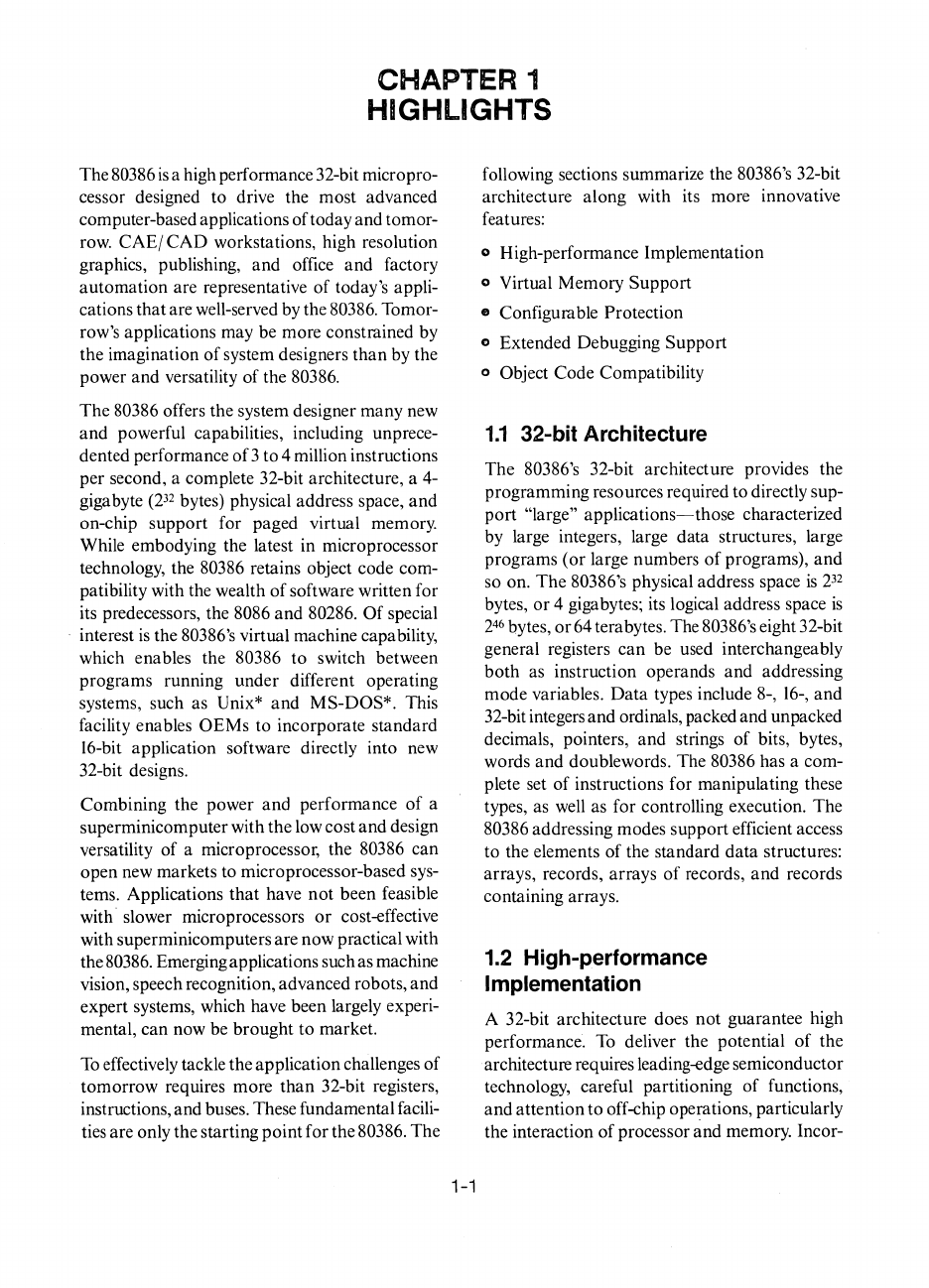
CHAPTER 1
HIGHLIGHTS
The 80386
is
a high performance 32-bit micropro-
cessor designed to drive the most advanced
computer-based applications of today and tomor-
row.
CAE(
CAD
workstations, high resolution
graphics, publishing, and office and factory
automation are representative of today's appli-
cations that are well-served
by
the
80386.
Tomor-
row's applications may be more constrained by
the imagination of system designers than by the
power and versatility of the
80386.
The 80386 offers the system designer many new
and powerful capabilities, including unprece-
dented performance of3 to 4 million instructions
per second, a complete 32-bit architecture, a
4-
gigabyte
(2
32
bytes) physical address space, and
on-chip support for paged virtual memory.
While embodying the latest in microprocessor
technology, the
80386 retains object code com-
patibility with the wealth of software written for
its predecessors, the
8086 and 80286. Of special
interest
is
the 80386's virtual machine capability,
which enables the
80386 to switch between
programs running under different operating
systems, such as
Unix* and MS-DOS*. This
facility enables
OEMs to incorporate standard
16-bit application software directly into new
32-bit designs.
Combining the power and performance of a
superminicomputer with the low cost and design
versatility of a microprocessor, the
80386 can
open new markets to microprocessor-based sys-
tems. Applications that have not been feasible
with
slower microprocessors
or
cost-effective
with superminicomputers are now practical with
the
80386.
Emerging applications such
as
machine
vision, speech recognition, advanced robots, and
expert systems, which have been largely experi-
mental, can now
be
brought to market.
To
effectively tackle the application challenges of
tomorrow requires more than 32-bit registers,
instructions, and buses. These fundamental facili-
ties are only the starting point for the
80386. The
1-1
following sections summarize the 80386's 32-bit
architecture along with its more innovative
features:
o High-performance Implementation
o Virtual Memory Support
e Configurable Protection
o Extended Debugging Support
o
Object Code Compatibility
1.1
32-bit Architecture
The 80386's 32-bit architecture provides the
programming resources required to directly sup-
port
"large"
applications-those
characterized
by large integers, large data structures, large
programs (or large numbers
of
programs), and
so on. The
80386's physical address space
is
2
32
bytes, or 4 gigabytes; its logical address space
is
2
46
bytes, or
64
terabytes. The 80386's eight 32-bit
general registers can be used interchangeably
both
as
instruction operands and addressing
mode variables. Data types include
8-,
16-,
and
32-bit integers and ordinals, packed and unpacked
decimals, pointers, and strings of bits, bytes,
words and doublewords. The
80386 has a com-
plete set of instructions for manipulating these
types,
as
well
as for controlling execution. The
80386 addressing modes support efficient access
to the elements of the standard data structures:
arrays, records, arrays of records, and records
containing arrays.
1.2 High-performance
Implementation
A 32-bit architecture does not guarantee high
performance.
To
deliver the potential of the
architecture requires leading-edge semiconductor
technology, careful partitioning of functions,
and attention to off-chip operations, particularly
the interaction of processor and memory. Incor-


















